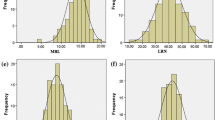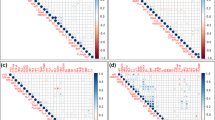Abstract
The phenotypic analysis of field experiments includes information about the experimental design, the randomization structure and a number of putative dependencies of environment and design factors on the trait investigated. In QTL studies, the genetic correlation across environments, which arises when the same set of lines is tested in multiple environments, plays an important role. This paper investigates the effect of model choice on the set and magnitude of detected root QTL in rice. Published studies on QTLs for root traits indicate that different results are obtained if varying genetic populations are used and also if different environmental conditions are included. An experiment was conducted with 168 RILs of the Bala × Azucena mapping population plus parents as checks under four environmental conditions (low light, low nitrogen, drought and a control environment). We propose a model that incorporates all relevant experimental information into a composite interval mapping approach based on a mixed model, which especially considers the correlation of genotypes in different environments. An extensive sequential model selection procedure was applied based on the phenotypic model, using the AIC to determine an appropriate random structure and Type 3 Wald F-tests for selection of fixed effects. In a first step we checked whether any of the fixed effects and random (nested) design effects could be dropped. Secondly, an appropriate covariance structure was chosen for genotype × environment interaction. In a third step Box-Cox transformations were applied based on residual analysis. We compared profiles of composite interval mapping scans with and without the inclusion of genotype × environment interaction and the experimental design information. Some distinct differences in profiles indicate that insufficient modeling of the non-QTL part can lead to an overly optimistic interpretation of QTL main effects in interval mapping. It is concluded that mixed model QTL mapping offers a reasonable way to separate environmental and genetic influences in the evaluation of quantitative genes and especially enables a more realistic assessment of QTL and QTL × environment effects than standard approaches by including all relevant effects.


Similar content being viewed by others
References
Basten C, Weir BS, Zeng Z-B (2001) QTL cartographer: a reference manual and tutorial for QTL mapping. Department of Statistics, North Carolina State University, Raleigh, NC
Boer MP, van Eeuwijk FA, Malosetti M (2007) A mixed model strategy for the detection of quantitative trait loci in multiple environmental trials. Euphytica (This issue)
Butler D, Cullis BR, Gilmour AR, Gogel BJ (2003) Spatial analysis with mixed models with S-Plus. SAMM reference manual. Training series QE02001, NSW Agriculture (pdf version)
Churchill GA, RW Doerge (1994) Empirical threshold values for Quantitative Trait Mapping. Genetics 138:963–971
Gilmour AR, Thompson R, Cullis BR (1995) Average Information REML, an efficient algorithm for variance parameter estimation in linear mixed models. Biometrics 51:1440–1450
Gilmour AR, Cullis BR, Welham SJ (2000) ASREML reference manual. NSW Agriculture, Orange, Australia
Insightful Corporation (2001) S-Plus 6 for Windows Guide to Statistics I + II. Seattle, WA
Jansen RC, Van Ooijen JW, Stam P, Lister C, Dean C (1994) Genotype-by-environment interaction in genetic mapping of multiple quantitative trait loci. Theor Appl Genet 91:33–37
Kao C-H (2000) On the differences between maximum likelihood and regression interval mapping in the analysis of quantitative trait loci. Genetics 156:855–865
Lander ES, Green P, Abrahamson J, Barlow A, Daly MJ, Lincoln SE, Newburg L (1987) MAPMAKER: an interactive computer package for constructing primary genetic linkage maps of experimental and natural populations. Genomics 1:174–181
Li ZK, Yu SB, Lafitte RH, Huang N, Courtois B, Hittalmani S, Vijayakumar CHM, Liu GF, Wang GC, Shashidhar HE, Zhuang JY, Zheng KL, Singh VP, Sidhu JS, Srivantaneeyakul S, Khush GS (2003) QTL × environment interactions in rice. I. Heading date and plant height. Theor Appl Genet 108:141–153
MacMillan K, Emrich K, Piepho HP, Mullins CE, Price AH (2006a) Assessing the importance of genotype × environment interaction for root traits in rice using a mapping population I: A soil-filled box screen. Theor Appl Genet 113:977–986
MacMillan K, Emrich K, Piepho HP, Mullins CE, Price AH (2006b) Assessing the importance of genotype × environment interaction for root traits in rice using a mapping population II: Conventional QTL analysis. Theoretical and Applied Genetics 113:953–964
Malosetti M, Ribaut JM, Vargas M, Crossa J, van Eeuwijk FA (2007) Multi-trait QTL Mixed Modeling with an Application to Drought Stress in Maize. Euphytica (This Issue)
Piepho HP (2000) A mixed-model approach to mapping quantitative trait loci in barley on the basis of multiple environment data. Genetics 156:2043–2050
Piepho HP (2005) Statistical tests for QTL and QTL-by-environment effects in segregating populations derived from line crosses. Theor Appl Genet 110:561–570
Piepho HP, Büchse A, Emrich K (2003) A hitchhiker’s guide to mixed models for randomized experiments. J Agron Crop Sci 190:230–247
Piepho HP, Williams ER, Fleck M (2006) A note on the analysis of designed experiments with complex treatment structure. HortScience 41:446–452
Price AH, Steele KA, Moore BJ, Jones RGW (2002) Upland rice grown in soil-filled chambers and exposed to contrasting water-deficit regimes: II. Mapping QTL for root morphology and distribution. Field Crop Res 76:25–43
Rebai A, Goffinet B, Mangin B (1994) Approximate thresholds of interval mapping tests for QTL detection. Genetics 138:235–240
SAS Institute, Inc (1999) SAS/STAT User’s Guide. Version 8. SAS Institute, Cary
Smith AB, Cullis BR, Thompson R (2005) The analysis of crop cultivar breeding and evaluation trials: an overview of current mixed model approaches. J Agric Sci, Cambridge 143:449–462
Wang DL, Zhu J, Li ZK, Paterson AH (1999) Mapping QTLs with epistatic effects and QTL × environment interactions by mixed linear model approaches. Theor Appl Genet 99:1255–1264
Zeng Z-B (1994) Precision mapping of quantitative trait loci. Genetics 136:1457–1468
Author information
Authors and Affiliations
Corresponding author
Rights and permissions
About this article
Cite this article
Emrich, K., Price, A. & Piepho, H.P. Assessing the importance of genotype × environment interaction for root traits in rice using a mapping population III: QTL analysis by mixed models. Euphytica 161, 229–240 (2008). https://doi.org/10.1007/s10681-008-9676-7
Received:
Accepted:
Published:
Issue Date:
DOI: https://doi.org/10.1007/s10681-008-9676-7




